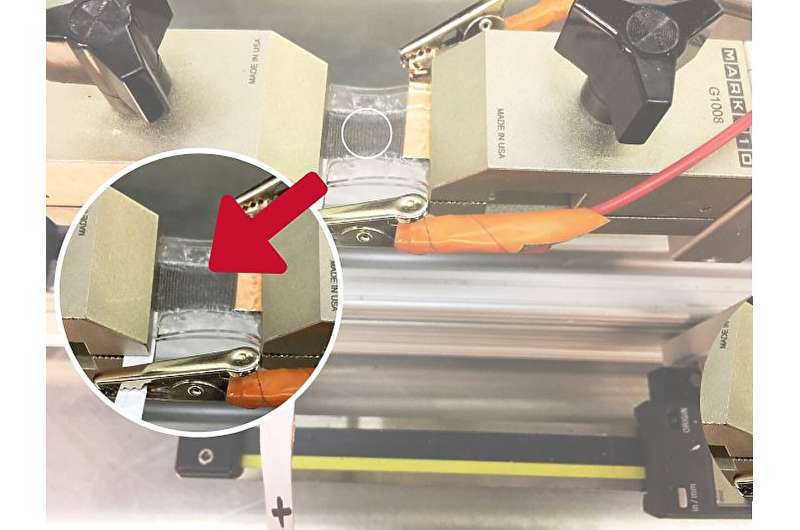This article has been reviewed according to Science X's editorial process and policies. Editors have highlighted the following attributes while ensuring the content's credibility:
fact-checked
trusted source
proofread
Researchers develop breakthrough prototype of stretchable fabric-based lithium-ion battery

Most people already know and appreciate the capabilities of smartphones. Now imagine the possibilities offered by smart spacesuits, uniforms and exercise clothes. The future of wearable technology has just received a big boost, thanks to a team of University of Houston researchers who designed, developed and delivered a successful prototype of a fully stretchable fabric-based lithium-ion battery.
The idea for this cutting-edge evolution of the lithium-ion battery came from the mind of Haleh Ardebili, Bill D. Cook Professor of Mechanical Engineering at UH.
"As a big science fiction fan, I could envision a 'science-fiction-esque future' where our clothes are smart, interactive and powered," she said. "It seemed a natural next step to create and integrate stretchable batteries with stretchable devices and clothing. Imagine folding or bending or stretching your laptop or phone in your pocket. Or using interactive sensors embedded in our clothes that monitor our health."
Some of these ideas are already becoming a reality. However, like all electronics, they need power, which is where the stretchable and flexible batteries come in. A major bottleneck in the development of the next generation of electronics or wearable technology embedded in fabrics is that conventional batteries are generally rigid, which limits functionality of the items, and they use a liquid electrolyte, which raises safety concerns. The traditional organic liquid electrolytes are flammable and can lead to the possibility of the batteries catching fire or even exploding under certain conditions.
The key to the UH research team's breakthrough lies in the researchers using conductive silver fabric as a platform and current collector.
"The weaved silver fabric was ideal for this since it mechanically deforms or stretches and still provides electrical conduction pathways necessary for the battery electrode to function well. The battery electrode must allow movement of both electrons and ions," said Ardebili, who is the corresponding author of a paper detailing this research in Extreme Mechanics Letters. The first author of the paper is Bahar Moradi Ghadi, a former doctoral student who based her dissertation on this research.
By transforming rigid lithium-ion battery electrodes into wearable, fabric-based, flexible, and stretchable electrodes, this technology opens up exciting possibilities by offering stable performance and safer properties for wearable devices and implantable biosensors.
How it all started
The idea for stretchable batteries occurred to Ardebili several years ago.
"I was interested in understanding the fundamental science and mechanisms related to stretching an electrochemical cell and its components," she said. "This was an unexplored field in science and engineering and a great area to investigate."
The science of coupling effects of mechanical deformation and electrochemical performance is an important field and stretchable batteries provide a great vehicle for exploring the fundamental mechanisms.
"Although we have created a prototype, we are still working on optimizing the battery design, materials and fabrication," said Ardebili.
Next steps
Ardebili is optimistic that the prototype for a stretchable fabric-based battery will pave the way for many types of applications such as smart space suits, consumer electronics embedded in garments that monitor people's health and devices that interact with humans at various levels. There are many possible designs and applications for safe, light, flexible and stretchable batteries, but there is still some work to be done before they are available on the market.
"Commercial viability depends on many factors such as scaling up the manufacturability of the product, cost and other factors," she said. "We are working toward those considerations and goals as we optimize and enhance our stretchable battery."
Whether the stretchy batteries end up powering spacesuits or workout clothes or some other innovative application, Ardebili wants them to be reliable and safe. "My goal is to make sure the batteries are as safe as possible," she said.
More information: Bahar Moradi Ghadi et al, Stretchable fabric-based lithium-ion battery, Extreme Mechanics Letters (2023). DOI: 10.1016/j.eml.2023.102026


















